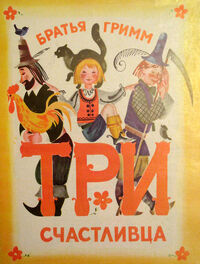
Front cover of a 1974 Russian-language picture book edition of "The Three Sons of Fortune".
"The Three Sons of Fortune" (German: "Die drei Glückskinder"; also published in English as "The Three Children of Fortune") is a German fairy tale. It is included in Kinder- und Hausmärchen (Children's and Household Tales), the anthology of German folktales compiled by the Brothers Grimm, from the 1819 second edition onward.
The story concerns three sons of a dying farmer. Since he has no money to leave to his sons, the old farmer instead gives his first son a rooster, his second son a scythe and his third son a cat. Each son is able to make his fortune out of what he has been left by his father. Each one goes to an island where the people have never before seen the object or animal he has been given, find it remarkable and pay handsomely for it. The introduction of a cat to an island where no cats have ever been seen before, however, has unforeseen consequences.
Plot[]

The old man and his three sons. 1910 illustration by the German artist Albert Weisgerber.
Not having any money to give them, an old farmer who believes that he will soon die, gives one of his possessions to each of his three sons. He gives the first one a rooster. He gives the second one a scythe. He gives the third one a cat. The farmer tells his sons that they have the greatest chance of making their fortunes out of what he has left them if they can travel to a place where roosters, scythes or cats are unknown.
The first son eventually finds an island where the people have never seen a rooster. The people of the island are impressed by the bird that helps them tell the time by crowing at two fixed hours during the night as well as just before dawn. The first son also tells them that if the rooster crows during the day, they can take that as a warning sign. The island people buy the rooster off the first son for as much gold as a donkey can carry.
The second son eventually finds an island where the people have great difficulty harvesting their crops because they have never seen a scythe. He sells the scythe to them for as much gold as a horse can carry.

The messenger speaks to the cat. 1910 illustration by the German artist Albert Weisgerber.
The third son eventually finds an island where the people have never seen a cat. Every house on the island is overrun with mice, even the king's palace. After the cat clears a few of the palace's room of mice, the king buys the cat for as much gold as a mule can carry. As a result, the third son becomes even richer than his two brothers.
After the cat kills and eats a great many mice, it becomes thirsty and mews so that it will be given something to drink. The people of the island have never heard the sound of a cat mewing before and are frightened by it. The king comes to believe that the cat is a monster. He and his courtiers flee the palace in terror. A messenger is sent back into the palace. The messenger asks the cat if it will leave the building. The cat mews again. The messenger interprets this as meaning, "No." It is decided that the only way to get rid of the cat is to destroy the palace. A cannon is fired at the palace. The building is destroyed. The cat, however, escapes unharmed when it jumps out of a window.
